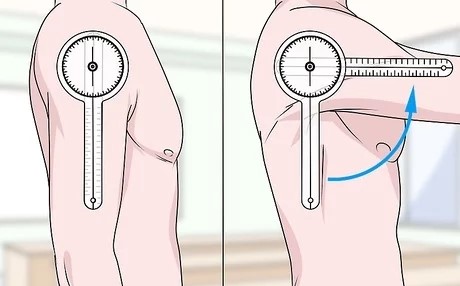What is Range of Motion?
Range of Motion
The first step to improving flexibility and learning about the functionality of our joints is to be familiar with the simple functions of joints, such as range of motion.
Because of that, I decided to write about a range of motion definition, different types and specific joint movements for different body parts .
The range of motion refers to the amount of joint’s ability to move in any direction to its limits. It depends on various factors such as joint structure, function, ligaments and muscles.
The most common directions are flexion and extension. A basic example would be bending or extending the knee.
Physical therapists measure it to see the function and health of the joint and surrounding tissue. Deviation of the normal range of motion leads to loss of functionality and an increased risk of arthritis/injury.
How is Range of Motion Measured?

Range of motion measures with a goniometer. A small plastic device that physical therapists use to see precisely the amount of movement for each joint.
Limited Range of Motion
If you can’t move your joint to its fullest potential, then you have a limited range of motion. Why should you be worried?
Let’s see a simple example of loss of ankle flexion. With a limited range of motion in the ankle joint, your knees would suffer from more pressure when you do squats.
During the deep squat, the knees would move more forward to compensate for the loss of ankle movement. That doesn’t mean injured knees right away or after a few years, but your form could be better and more efficient.
Learn more about how to increase range of motion.
Range of Motion: Factors
Different factors are responsible for your range of motion in the joints. Some of them may include:
- Sedentary or active lifestyle
- Posture
- Injuries
- Sport-specific activities
- Muscle strength
- Job type
A sedentary lifestyle, poor posture and awkward working position will reduce the range of motion in a specific joint or body part. The reason is that without active and proper muscle activation, the range of motion is compromised.
Types of Range of Motion
Active, passive and active-assisted range of motion uses to test different capabilities of joints and muscle structures.
Active ROM
Active ROM means that a person can move actively, without help from others. Muscles are responsible for movement. In most cases, the active range of motion is less than passive.
Rehabilitation from joint lesions and maintaining soft tissue health are some of the benefits of active movement. Increasing joint mobility and muscle strength, you will get better functionality overall.
Passive ROM
The passive motion describes a movement performed by a therapist or machine. The focus is on testing the joint structure, improving the range of motion significantly and fighting the contractures.
Passive ROM applies when you are not able to move. After surgery, paralyze or with painful movements. It is a comprehensive tool for early-stage rehabilitation.
Active Assisted Range of Motion
Active assisted ROM uses as a part of rehabilitation protocol when you are not able to move your injured body part to the fullest. To ensure that movement isn’t hurting joint structures, a therapist helps you move your body.
Active vs Passive Rom?
The difference between the active and passive range of motion is significant. Passive ROM uses after surgery or with the stretching season, but it has its limits. Muscles are inactive.
Effects from passive ROM are not long-term and you shouldn’t limit yourself just to passive range of motion.
On the other hand, active ROM is every move we do actively. It is dominant in rehabilitation and sports activities. Improved joint stability, muscle strength and flexibility, heart and lungs health are some of the benefits active ROM offers.
Joint Movements
Shoulder Range of Motion
The shoulder joint offers a huge amount of mobility and range of motion. We are going to cover the basic movements and their normal range of motion.
Normal Shoulder Range of Motion
- Flexion – 180°
- Extension – 45-60°
- Abduction – 150°
- Adduction – 30-50°
- Medial rotation – 70-90°
- Lateral rotation – 90°
Knee Range of Motion
- Flexion – 0 to 130°
- Extension – 120 to 0°
Hip Range of Motion
- Flexion – 0 to 125°
- Extension – 115 to 0°
- Hyperextension – 0 to 15°
- Abduction – 0 to 45°
- Adduction – 45 to 0°
- Medial rotation – 0 to 45°
- Lateral rotation – 0 to 45°
Ankle Range of Motion
- Dorsiflexion – 0 to 20°
- Plantarflexion – 0 to 50°
- Inversion – 0 to 35°
- Eversion – 0 to 25°
Wrist Range of Motion
- Flexion – 0 to 90°
- Extension – 0 to 70°
- Abduction – 0 to 25°
- Adduction – 0 to 65°
Thumb Range of Motion
- Flexion – 0 to 90°
- Extension – 90 to 0°
Neck Range of Motion
- Flexion – touch chest with chin
- Extension – 55°
- Rotation – 30°
- Lateral flexion – 40°
Lumbar Range of Motion
- Flexion – 60°
- Extension – 25°
- Lateral flexion – 25°
More Information About Flexibility
- Limited range of motion/flexibility – In this blog post, you can learn more about what is a limited range of motion in joints and what is causing it. It is very hard to maintain good flexibility over a long period and that’s one of the biggest reasons for me to write about that topic.
- How to increase range of motion/flexibility – Improving flexibility is not achieved only by classic stretching training. In this blog post, I covered 13 different activities/treatments that you can use to improve flexibility.
- Joint by joint approach – The unique way of thinking that has been developed by physical therapist Gray Cook. He explain connection between joints and their requirements for stability and/or mobility in order to maintain proper function and to avoid injuries. This is one of my favorite methods because it is straightforward and opens a whole new way of analyzing body function.
- 10 Types of stretching exercises – What stretching exercise type do you prefer? Here you can read more about different stretching exercises and types of stretching. From static to ballistic stretching exercises.
